This book is a photographic record of diverted trains in different regions of the UK, often with unusual motive power, running on lines that don’t usually see that type of traffic, or with electric traction being hauled by a diesel locomotive.
Published in October 2022 as part of Pen & Sword’s “Train Craft” series and written by Kim Fullbrook, the book measures around 17.15 cm x 24.13 cm and has 120 pages and 200 colour illustrations.
It has a published price of £25, but at the time of writing Pen & Sword has it on offer online for £17.50 and it can be obtained from Amazon for £19.02.
One of the challenges of operating a rail network in the UK is dealing with disruptions and diversions caused by various factors, such as maintenance work, accidents, or weather conditions.
In some cases, trains have to use alternative routes to reach their destinations, which may involve travelling on less familiar or more difficult lines.
Although in recent years, the use of rail replacement buses has become commonplace, this book illustrates rail services that were not replaced by buses but were diverted.
For many years, Class 47 diesels and HSTs were the mainstay of trains throughout the UK, and they naturally feature in many of the pictures, but there are also plenty of other types of motive power. Some of the photos are of the same locations taken many years apart, and it is fascinating how the infrastructure has changed over the intervening years.
Kim Fullbrook started photographing diversions at Cambridge in 1980 when engineering work on the East Coast Main Line resulted in Deltics hauling passenger trains being diverted through the city.
From there, his passion took him across the country capturing photographs of unusual workings, and his captions add plenty of detail, whilst the many different classes and liveries, and passenger and freight trains, provide a fascinating collection.
In the London area, few diversionary routes exist, but one of these is the Lea Valley line, which runs parallel to the West Anglia Main Line from Stratford to Broxbourne.
The photo in the top left shows Class 37 No. 37110 on a diversion when the Lea Valley line itself was closed. When the West Coast Main Line is closed in the north of England, trains can use the Settle-Carlisle route to reach Scotland but to do so they often have to use the line from Blackburn to Hellifield, which is known as the Ribble Valley line, and the photo at the bottom left shows Class 47 No. 47403 crossing the impressive Whalley Arches viaduct.
In the Manchester area, there are plenty of opportunities for diversion, such as in the photograph at the top right which shows Class 47 No. 47588 crossing a bridge over the Manchester Ship Canal at Irlam on the line from Liverpool to Manchester via Warrington Bank Quay.
One of the most unusual pilot engines for a diverted train is that seen at the bottom right, where Class 58 No. 58014 is piloting Class 86 electric No. 86239 through Nuneaton on the Trent Valley section of the West Coast Main Line.
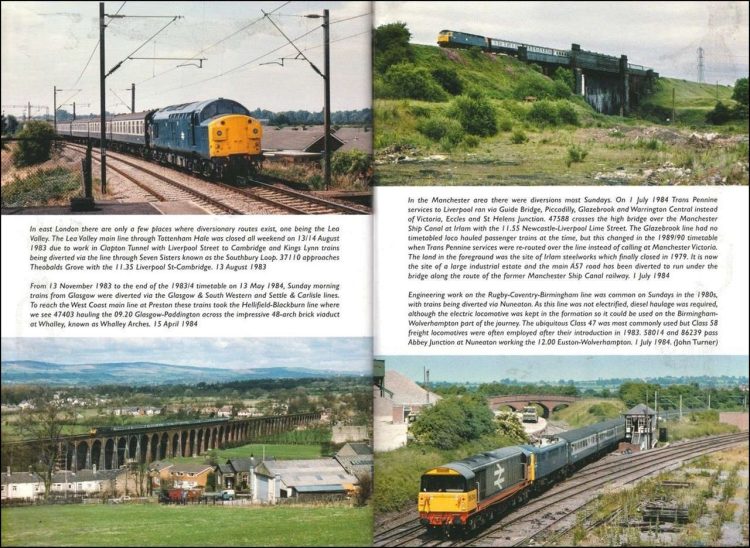
With the semaphore signals and signal box, the photo at the top right looks like a throwback to the days of steam, but here a Virgin Cross Country service has been diverted from the East Coast Main Line to run via Billingham.
Before the completion of HS1, Eurostar trains such as the one at the bottom right provided new journey experiences when diverted along traditional 750V d.c. Lines.
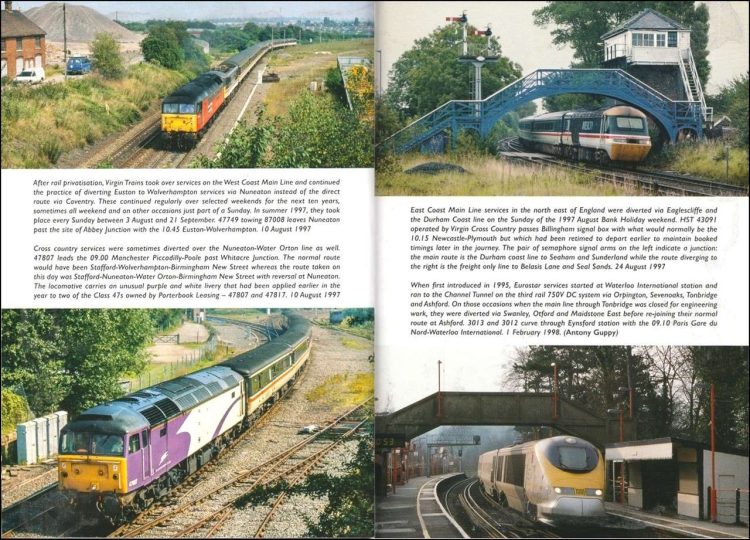
When the Great Western main line from Paddington to Bristol is closed between Didcot and Swindon, an alternative route is from Reading via Westbury, as seen in the photos on the left showing diverted trains at Thingley Junction near Chippenham and approaching Freshford near Bath.
A number of diversionary routes are available around Birmingham, with many diverted trains going via Nuneaton such as the Virgin Cross Country train seen at the top right that would normally go direct from Coventry to Birmingham being diverted by this route, and Class 47 No. 47827 at the bottom-right with a Southampton Central to Manchester Piccadilly service.
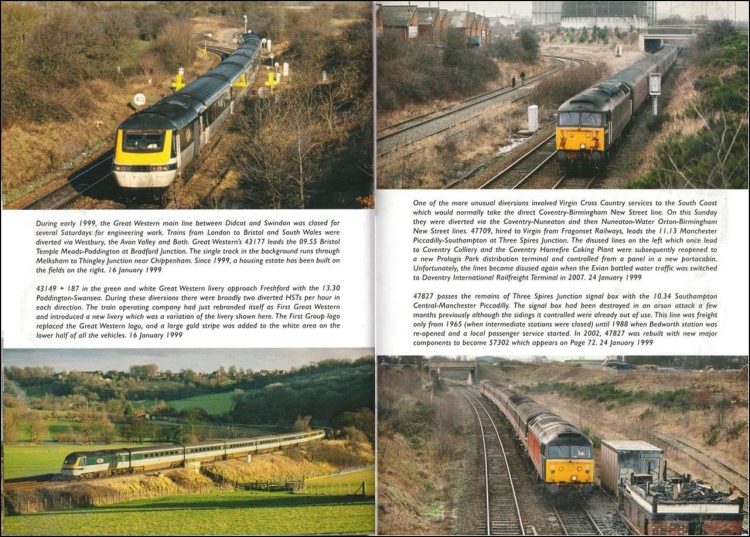
When electric trains are diverted they will often need a diesel locomotive to pilot them over the non-electrified lines. That is what has happened on the left-hand page with Class 47 No. 47773 piloting Class 90 No. 90035 on a postal train diverted from the West Coast Main Line to run via the then non-electrified Midland Main Line.
Freight-only lines are often used as diversionary routes, such as in the two photos on the right-hand page below showing trains diverted along unusual lines in the Bristol area, with at the top a five-car Voyager on the single-line from Narroways Hill Junction to Avonmouth, and below it Class 158s Nos. 158749 and 158866 joining the line from Severn Beach to Bristol Temple Meads.
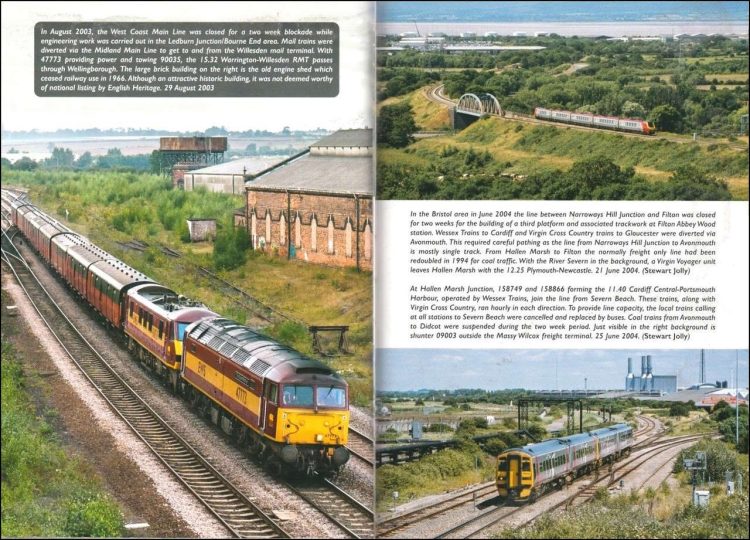
Occasionally, diversionary routes add an inordinate amount of mileage to a service, such as when the line between Didcot to Bicester was blocked. At that time the trains on the left-hand page ran an extra 120 miles via South Ruislip.
Similarly, the train at the top right is seen approaching Harringay on the East Coast Main Line after its overnight Sleeper service from Scotland was diverted to Kings Cross and then went via a roundabout route to Wembley for servicing.
Although most diverted trains get their passengers to their intended destinations, that was not the case with the train shown at the bottom right, where because the railway line to Fort William was blocked north of Crianlarich, the service was diverted to Oban, 40 miles away.
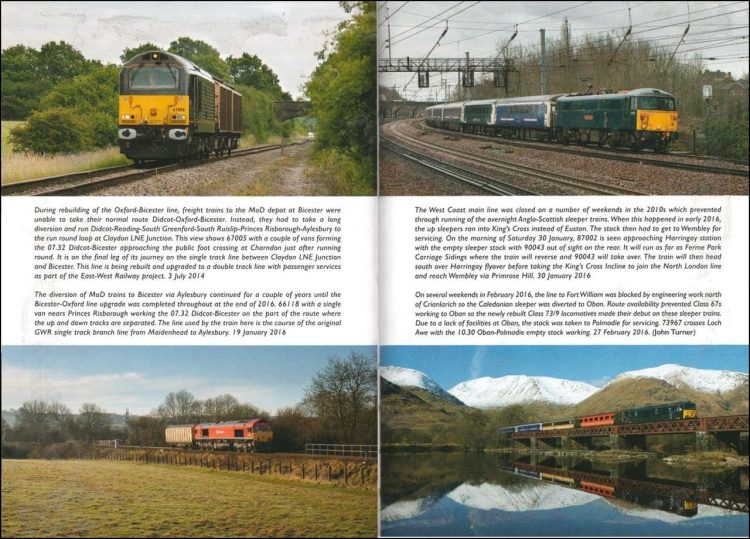
Diversions often brought excitement to railway enthusiasts as they would often be treated to classes of locomotives not normally seen in their local area.
The author’s interest in diverted trains began in Cambridge, and the trains in the pages below must have been a delight to him and other local enthusiasts, with Deltics and a Class 46 diesel bringing variety to their local scene.
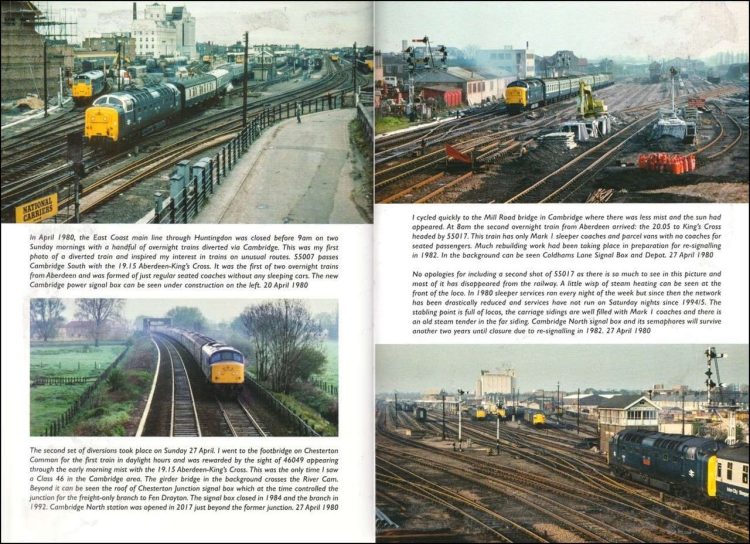
The author has captured an interesting selection of diverted passenger and freight trains, often with unusual motive power or running on lines that don’t normally see that type of traffic. Despite the book’s title of Diesels Diverted, a number of the photographs show electric traction being hauled by a diesel locomotive.
During the 40 years covered by the book, Class 47s and HSTs were the mainstay of trains throughout the UK. They therefore naturally feature in many of the photographs, but there are also plenty of other types of motive power, including an unusual pairing of a Class 58 diesel hauling a Class 86 electric locomotive.
The author’s photographic technique is outstanding, in many cases including the surrounding railway infrastructure as well as the trains in question. His passion for capturing photographs of unusual workings has resulted in this fascinating book, enhanced by detailed captions that put the diversions in context. Recommended, but let down by the lack of page numbers.
The book is available to purchase from Amazon and from Pen & Sword.
We would like to thank Pen & Sword for providing RailAdvent with a copy of the book for review.




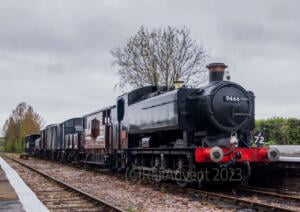

Responses